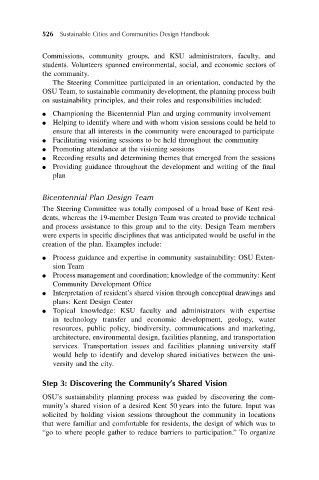Page 557 - Sustainable Cities and Communities Design Handbook
P. 557
526 Sustainable Cities and Communities Design Handbook
Commissions, community groups, and KSU administrators, faculty, and
students. Volunteers spanned environmental, social, and economic sectors of
the community.
The Steering Committee participated in an orientation, conducted by the
OSU Team, to sustainable community development, the planning process built
on sustainability principles, and their roles and responsibilities included:
l Championing the Bicentennial Plan and urging community involvement
l Helping to identify where and with whom vision sessions could be held to
ensure that all interests in the community were encouraged to participate
l Facilitating visioning sessions to be held throughout the community
l Promoting attendance at the visioning sessions
l Recording results and determining themes that emerged from the sessions
l Providing guidance throughout the development and writing of the final
plan
Bicentennial Plan Design Team
The Steering Committee was totally composed of a broad base of Kent resi-
dents, whereas the 19-member Design Team was created to provide technical
and process assistance to this group and to the city. Design Team members
were experts in specific disciplines that was anticipated would be useful in the
creation of the plan. Examples include:
l Process guidance and expertise in community sustainability: OSU Exten-
sion Team
l Process management and coordination; knowledge of the community: Kent
Community Development Office
l Interpretation of resident’s shared vision through conceptual drawings and
plans: Kent Design Center
l Topical knowledge: KSU faculty and administrators with expertise
in technology transfer and economic development, geology, water
resources, public policy, biodiversity, communications and marketing,
architecture, environmental design, facilities planning, and transportation
services. Transportation issues and facilities planning university staff
would help to identify and develop shared initiatives between the uni-
versity and the city.
Step 3: Discovering the Community’s Shared Vision
OSU’s sustainability planning process was guided by discovering the com-
munity’s shared vision of a desired Kent 50 years into the future. Input was
solicited by holding vision sessions throughout the community in locations
that were familiar and comfortable for residents, the design of which was to
“go to where people gather to reduce barriers to participation.” To organize

